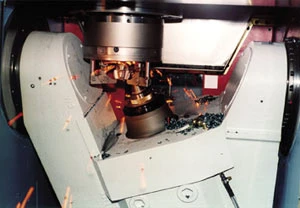
Helpful tips for getting the best, customized workholding solution.
With manufacturing operations using higher cutting speeds that place greater force on workholding equipment, choosing the best and most accurate system to hold your work is trickier than ever. Careful examination of your clamping application may lead you to either a ready-made solution, or a customized workholding answer.
One vendor, Emuge Corp. (West Boylston, MA), has a workholding division that provides tailored solutions for troublesome workpieces. They specialize in fixtures that demand the highest accuracy and repeatability in a broad market, which includes low volume job shops through high volume automotive production environments.
Dave Jones, Emuge Sales Engineer, explains, "Our workholding group stays close to our customers to learn about their unique challenges and production environments. Doing so helps us avoid potential miscommunication and minimizes additional project costs."
Jones and his team offer the following tips for obtaining a unique clamping solution:
Establish open communication. Be sure your vendor has an open ear beginning early on in the quotation process. It is critical that they understand the requirements for your entire operation.
Supply your vendor with complete operation specifications, and then keep them informed of any changes to these specs even if you feel these modifications are not workholding related.
"When we stay close to our customer, we are usually kept informed without even asking. However, even when we are receiving timely updates, changes to the original specs may lead to some added cost or a delay in project delivery because the design or the build process may be too far along.
"This is where the flexibility of Emuge's workholding devices is really put to the test. In most cases, our designs allow us to react and adapt quickly to minimize the impact of unforeseen changes," says Jones.
DIFFICULT WORKPIECE CONSIDERATIONS. If you are taking the route of having a custom workholding solution produced for you, chances are you are dealing with a difficult workpiece and/or operating environment.
For instance, one challenge is holding thin wall parts while performing operations with high, transferable torque values. Emuge's System SG (based on a series of short tapers) spreads the clamping forces over the largest possible area of the workpiece. The result is a very rigid, accurate and repeatable workholding solution for these types of difficult workpieces. System SG is commonly used for hobbing, shaping, shaving, turning, grinding and inspection applications.
ENSURE ALL AREAS OF YOUR SYSTEM ARE ACCURATE. Not only should the new clamping system be precise, but several other related areas of the operation should also be reviewed to ensure the best possible results. Look at the production environment and tooling, and make sure these areas are suitable for your application (don't simply rely on what has worked in the past). The accuracy of the locating and clamping surfaces on the workpiece should also be considered. Further, a clean workpiece yields the best end product. When debris builds up in the clamping area of a workpiece, it may affect how the piece is being held, and negatively affect the outcome of the entire operation.
CONSIDER THE VOLUME OF WORK TO BE PERFORMED ON YOUR WORKHOLDING DEVICE. If work volume is planned to be high, then a mechanical workholding solution might be the answer. In the case where the workpiece has a challenging bore-to-length ratio, a hydraulic system may be an alternative.
Emuge does offer hydraulic arbors, but in cases where the volume is considered to be high, a mechanical solution that we would offer is our System SP. "The System SP is our most accurate system," states Jones. "It has high accuracy and repeatability and touts the reliability of a mechanical system. The System SP can also be used in other high-accuracy areas like tool holding, grinding or workpiece inspection."
ABILITY TO USE YOUR WORKHOLDING SOLUTION NOW AND LATER. Try to choose a clamping solution that will serve you now and also into the future. When your vendor is designing the fixture, take the time to convey what you believe your needs will be down the line. Perhaps the workpiece is just one of many in a series or part family. This may mean that relatively minor changes would have to be made to the workholding device to accommodate the new workpieces.
For instance, Emuge's Systems SP, SG, SM and SZ can easily adapt to a workpiece change within a range. In some cases all that will be required for a change in diameter is a new clamping sleeve that is designed to match the new clamping diameter.
Selecting the best workholding system for your needs will ultimately lead to a better end product. By following some of the guidelines provided and by staying close with your vendor, you can meet the challenges of today's demanding production environments.

Explore the March 2007 Issue
Check out more from this issue and find your next story to read.
Latest from Today's Medical Developments
- Arcline to sell Medical Manufacturing Technologies to Perimeter Solutions
- Decline in German machine tool orders bottoming out
- Analysis, trends, and forecasts for the future of additive manufacturing
- BlueForge Alliance Webinar Series Part III: Integrate Nationally, Catalyze Locally
- Robot orders accelerate in Q3
- Pro Shrink TubeChiller makes shrink-fit tool holding safer, easier
- Revolutionizing biocompatibility: The role of amnion in next-generation medical devices
- #56 Lunch + Learn Podcast with Techman Robot + AMET Inc.





